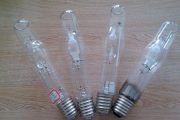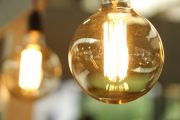Both Metal Halide and High Pressure Sodium bulbs are part of the HID family of bulbs. The primary visual difference between them is that metal halide light is white and the light emitted from a High Pressure Sodium bulb is amber orange. The lamp works by creating an electric arc through vaporized sodium metal. Other materials and gases are used to help start the lamp or control its colour.
High Pressure Sodium Vapor (HPS) lights are a specific type of gas-discharge light (also known as a High Intensity Discharge, HID or arc light). The principal difference between low and high pressure sodium lights is the operating pressure inside the lamp. As indicated by the name, “high” pressure sodium vapor lights operate at a higher internal pressure.
Where are HPS lamps commonly used?
High-pressure sodium lamps (sometimes called HPS lights) have been widely used in industrial lighting, especially in large manufacturing facilities, and are commonly used as plant grow lights. They contain mercury. They have also been widely used for outdoor area lighting, such as on roadways, parking lots, and security areas. Understanding the change in human color vision sensitivity from photopic to mesopic and scotopic is essential for proper planning when designing lighting for roadways.
Advantages of High Pressure Sodium lamps:
Lumen: Maintain their luminance for 90% of their life span, and still maintain 80% emission at the end of their life.
Lifespan: High Pressure Sodium lights tend to have a lifespan averaging 24,000 hours.
Efficacy: High efficacy that is easily comparable to LED lights.
Color Temperature: Average 2000K, known for their warm yellow glow.
CRI: Disconcerting color rendering (CRI) that can inhibit vision at night and create darker shadows.
Bulb Failure: Prone to flickering and activation failure. At the end of the bulbs’ lives, they are more susceptible t turning on and off without input until they inevitably fail entirely.
Price: High Pressure Sodium lights are cheaper.
The main benefit of using HPS is that they are the only light source with a similar efficiency to LEDs and maintain luminescence fairy well. They also do have great lifespans – around 24,000 hours – though this is significantly less than LEDs. They also are fairly cheap to purchase and cheap to maintain, and do not emit infrared or UV radiation.
Disadvantages of High Pressure Sodium lamps:
One main drawback to high pressure sodium lighting is that it has a yellow hue that simply doesn’t show you how things really look. Although they are very popular for street lights, they don’t serve many other applications. If your only concern is seeing your way through a parking lot or down a roadway, that may be good enough. They also have the worst CRI of any light source, falling around a 25 and like Metal Halides, require a warm-up period and may flicker or cycle on and off at the end of life.
Because of HPS efficiency, this has been deemed adequate for many years. But its low quality of the lighting means that — when HPS lights are used — it may be difficult to distinguish a car in a full parking lot, and security cameras or witnesses may not be able to identify people if a crime has taken place. There’s also evidence that whiter lights can help with a driver’s peripheral vision and stopping time.
Like Metal Halides, High Pressure Sodium lights are omnidirectional, which wastes light and makes them less efficient. They lose roughly 15% of their heat emissions which adds to their inefficiency.
HPS light costs differ based on the particular fixtures, but are cheap compared to LEDs. However, they are very fragile and operate with a glass bulb, making them unsafe for hazardous or explosive environments. This makes maintenance and replacement costs much higher than LEDs and more comparable to Metal Halides.
Why do people choose LED lights?
Here are some main advantages of LED lights:
Longer lifespan
LEDs have a lifespan of up to 60,000 hours as opposed to 1,500 hours typical of incandescent bulbs. A great LED light can last over 7 years of constant use before needing a replacement. Usually, LED bulbs last ten times as long as small fluorescent bulbs and 133 times longer than typical incandescent bulbs. The long lifetime of LEDs will drastically reduce maintenance costs and lower long-term operating costs compared to traditional amoureux and fluorescent lights.
Energy efficient and recyclable
LED’s are the most energy efficient bulb. 80-90% of the energy in an LED is converted into light, in comparison to incandescent bulbs where only 20% of the energy is converted into light and a whopping 80% is turned into heat! LED’s also use lower amounts of electricity, approximately 60% less than traditional bulbs in our experience. LED bulbs are also 100% recyclable, so using LED’s can help to reduce your carbon footprint by a third.
Conducive to people’s lives
Not only are LED’s better for the environment, but they are better for people too! From recent developments, LED lights can now mimic natural outdoor light, and this results in a healthier and more regular circadian rhythm. Another health benefit is reduction in stress levels, because its proven that spending a day outdoors makes you feel much better, so mimicking this outdoor light has been associated with reduced levels of stress and anxiety in indoor environments, making people feel happier.
Research also shows that having LED’s installed into a school or work environment increases productivity and stimulates learning performance, meaning there are many benefits of LED lighting in offices and schools alike.
This is why people prefer LED lights, its development is becoming a trend. HPS lights have some commons with Metal Halid Lights. We roughly estimate that our 300-500 LED lights can simply replace 1000W HPS light.







